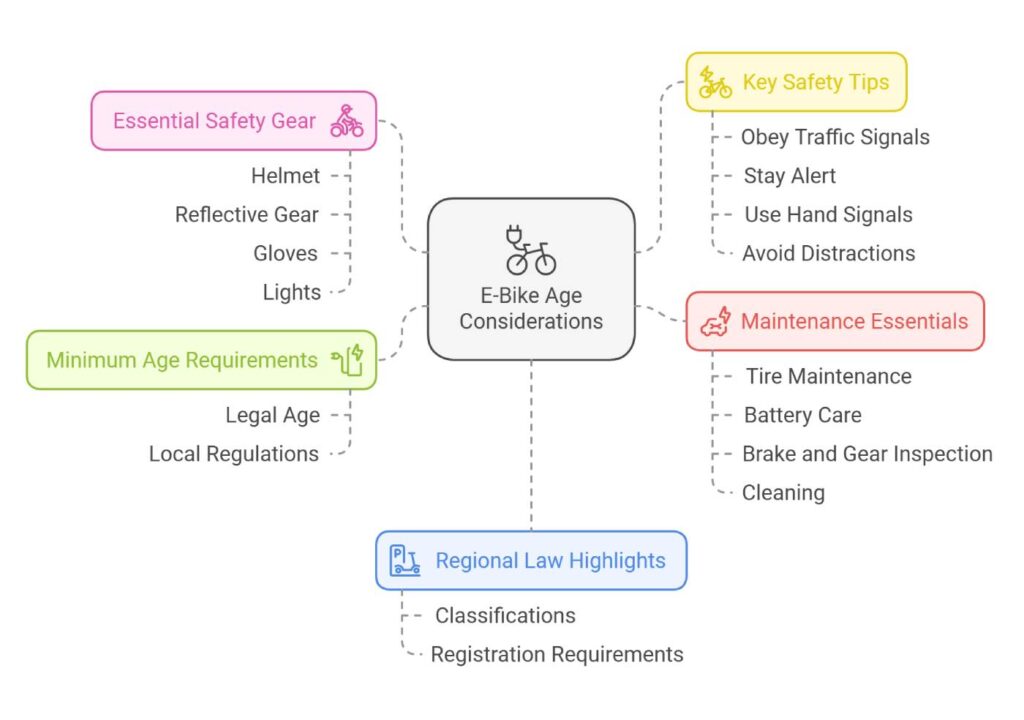Embarking on the e-bike journey is exhilarating, but knowing the right age to ride is crucial for safety and enjoyment. Whether you’re a parent considering an electric bike for your teen or a young rider eager to hit the streets, understanding age-related guidelines can make all the difference.
Dive into our comprehensive guide where we unravel the complexities of e-bike age considerations, ensuring every ride is both fun and safe.
From legal regulations across the globe to essential safety gear, empower your cycling adventures with the knowledge you need to navigate the electric bike landscape confidently.
Electric Bikes and Age Considerations
Picking the right age for starting on an electric bike (e-bike) ain’t just about buying a nice ride. It’s about being smart with safety and following the rules.
Children and Electric Bikes
Handing an e-bike over to youngsters? Not such a hot idea. Experts say kids should be at least 16 years old before they hop on one. A tragic reminder of this is the story of Molly Steinsapir, a 12-year-old who died in an e-bike accident, showing the real risks of letting young kids ride these speedy machines.
The American Academy of Pediatrics has a thing or two to say about this, too. They push the idea that kids under 16 shouldn’t be on anything motorized like an e-bike; their bodies and minds just aren’t ready for the speed and power involved.
Different places have laws to keep things safe. Like, in Israel and a heap of US states, you gotta be 16 to legally ride these zippy bikes. These rules aren’t there to cramp a kid’s style—their goal is to make sure riders know the sparks from their sprockets when zooming around.
Risks and Safety Concerns
E-bikes can be a wild ride, but they’re not without a few bumps on the road. When kids take the reins, a few things could go wrong:
- Busted Up Bodies: E-bike accidents can be nastier than your regular bike mishaps, with injuries that might land you in the ER with serious stuff like organ damage—not fun!
- Out and About Blunders: A kid with a speeding e-bike could easily spook or even hurt pedestrians. Who knew a bike ride could make you a menace on wheels?
- Greenhorn Gaffes: Younger folks often lack experience which means they’re not fully clued up on handling traffic and such on these high-powered rides.
- Misuse Mayhem: There’s chatter about even smaller kids, some as young as eight, barreling around cities on e-bikes. That’s got people worried about what could go wrong in those cases.
| Age Group | Legal Status | Considerations |
|---|---|---|
| Under 16 | No-Go | Not enough experience, high injury risk |
| 16 and up | Green Light | Allowed in most spots, more mature, road-ready |
Knowing the rules, sticking to age limits, and spreading the word about e-bike safety can keep riders on two wheels and out of trouble. For the nitty-gritty on e-bike regs, check out our deep dive on electric bike laws.

Age Restrictions and Regulations
Knowing the rules about who can ride electric bikes is key to keeping things safe and fun. Rules differ depending on where you are, so it’s smart for riders and those looking after them to be clued in and play by the book.
Age Restrictions Across Different Regions
Who’s allowed on an electric bike and when varies, and not just a little bit. Some places let young guns ride with some conditions, while other spots crack down harder.
| Region | Minimum Age | Little Extras You Should Know |
|---|---|---|
| United States (Federal) | No big rule | Depends on the state; 16 is a popular choice for a minimum in many places |
| United Kingdom | 14 | Helms on, and stick to regular bike traffic rules |
| Canada | 12-16 | Changes with the province; some want you to gear up more |
| Australia | 16 | Sticking to public roads is a no; helmets are a yes |
| European Union | 14-16 | Depends on the country; road rules are your new best friend |
For nitty-gritty details in the U.S., take a peek at electric bike laws.
International Regulations on E-Bike Use
Around the globe, e-bike rules aim to keep things safe and sound, making sure you’re not zooming around haphazardly. Many include must-have safety gear, speed limits, and make sure young riders know their stuff first.
Over in the European Union, 14 to 16 is the magic number for hopping on an electric bike, but that’s just a starting point. Each country’s got its own say, and sticking to road rules is a must.
Here in the U.S., there’s no blanket rule for age, but you bet states have their own takes. Many say 16’s the age, but, for instance, California wants those under 18 to don helmets.
Canada’s pretty chill, with provinces doing their own thing. In Ontario, you need to be at least 16 and rocking a helmet. Meanwhile, Quebec’s okay with 12-year-olds, but there’s a catch—they need an adult nearby.
Australia’s standing firm at 16 for road riding, helmet on. Speed’s cut to 25 km/h to avoid mishaps, a nod to those spills motorcycles see too often.
Hop on over to Asia and beyond, and you’ll find a mixed bag of rules. Double-check the local laws to avoid getting side-eyed.
Young riders should definitely get some know-how training, play by the local rules, and always suit up. It’s a solid step towards keeping everyone out of scrapes.
Curious about what e-bike fits a teen best? Check out ebike classifications. For a world tour of e-bike laws, hit up electric bike laws.
Choosing the Right Electric Bike for Teens
Picking out the perfect e-bike for a teenager isn’t as simple as grabbing the coolest-looking one in the shop. Teens have their own needs and let’s face it, safety comes first. So how do you find the right electric bike for your young rider? Here’s some down-to-earth advice to help steer you in the right direction.
Factors to Consider for Teen Riders
- Age Check: Doctors and smart folks at places like the American Academy of Pediatrics suggest keeping e-bikes away from kids under 16. They reckon handling anything with a motor can be a bit too much for their growing brains and bodies.
- Safety First: Brakes that work like a charm, lights that actually light up, and a bell that won’t let you down—all must-haves on an e-bike. Oh, and don’t skimp on gear like helmets or anything that reflects the light.
- Speed Control: Some e-bikes can go faster than you might want Junior going. Look for ones with speed limit features or smaller engines to keep things chill.
- Size Matters: Make sure the bike fits the rider—big bikes and small teens are not a good match.
- School’s in Session: Road rules aren’t just for cars. Get the kids into a training session or two so they know how to stay safe out there.
Selecting the Appropriate E-Bike Model
Here are some e-bikes we think stand out from the crowd, ticking most of those teen boxes mentioned.
| Criteria | Recommended Models |
|---|---|
| Speed Control | ANCHEER 350W Electric Mountain Bike, Swagtron EB-5 Pro Plus |
| Light and Easy | Ancheer Folding Electric Commuter Bike, Jetson Bolt Pro Folding Electric Bike |
| Tweaker’s Dream | Ancheer Power Plus Electric Mountain Bike, Razor EcoSmart Metro Electric Scooter |
| Safety All the Way | Lectric XP Step-Thru Electric Bike, Aventon Pace 350 Step-Thru |
Models Detailed Analysis
- ANCHEER 350W Electric Mountain Bike: This one’s got a speed governor and a solid frame which keeps teens in their safety zone without skimping on fun.
- Swagtron EB-5 Pro Plus: It’s compact, light, and folds like a charm, perfect for the teen who’s always on the go.
- Jetson Bolt Pro Folding Electric Bike: Great for city slickers, this e-bike tackles everyday rides with safety and style.
- Lectric XP Step-Thru Electric Bike: With its easy step-thru frame and night lights, this bike gets top marks for safety features.
- Aventon Pace 350 Step-Thru: Prioritizing comfort and safety, it’s got a step-thru design and a balanced ride ideal for young riders still finding their feet.
Teens dipping their toes into the e-bike world should load up on safety tips for e-bike riders. Gathering the right gear and know-how helps keep the roads friendlier. By thinking through these details and picking wisely, teens can saddle up for fun yet safe rides. Learn more about e-bike classifications and electric bike laws in our detailed articles.
Safety Measures for Teen E-Bike Riders
Keeping teens safe on e-bikes should be a number one on your list. This means getting them hooked up with the right gear and giving them the skinny on road safety actions.
Essential Safety Gear for Adolescents
Before teens hit the road on their e-bikes, they better be packing the right safety kit. Top of that list? Helmets. They’re like your noggin’s knight in shining armor if you take a spill. Then, there are elbow and knee pads—think of them as the bouncers for your joints, ready to step in if things get rough.
| Safety Gear | Importance |
|---|---|
| Helmet | Keeps your head protected during falls or crashes |
| Elbow Guards | Shields your elbows from scrapes and cracks |
| Knee Guards | Your knees’ first line of defense against hits and bruises |
| Reflective Clothing | Lights you up for those around you when it’s dark |
| Gloves | Grips and safeguarding those paws from scrapes |
Want the full scoop on safety gear? Dive into our handy ebike safety features guide.
Training and Road Safety Education
Teens need to be like e-bike safety ninjas, knowing the ins and outs of riding safely with cars around. This isn’t just about flipping through a rule book—it’s about hitting the road with the skills to keep out of trouble. Training should tick off bits like:
- Understanding Traffic Laws: Teens need to know stuff like stopping at red lights, giving folks on foot their right of way, and sticking to speed rules.
- Use of Hand Signals: Making sure drivers know what you’re up to by using hand signals can be a game-changer.
- Lane Riding: Keep it cool in the bike lane, and avoid dodging in between cars like it’s a video game.
- Hazard Awareness: Spotting things like potholes, slick surfaces, or sudden surprises keeps riders from biting the dust.
Think about sending your kid to a bike safety class for a crash course (pun intended) in not crashing. More tips can be found where you least expect them, maybe our article on tips for straightening curly hair?
Hooking up your teens with gear and legit training means they get to love e-biking without sweating the risks. Curious about keeping that e-bike in prime condition? Check our electric bike maintenance guide for expert advice.
Maintenance and Riding Practices
Keeping electric bikes in tip-top shape isn’t just smart, it’s essential, especially if you’ve got a young rider zipping around on one. This part spills the beans on keeping things running smoothly and staying safe on the road for teenagers.
Scheduled Maintenance Audits
Regularly checking your e-bike is a no-brainer if you want it to last and not conk out when you least expect it. Teen riders should get a handle on the basics:
| Maintenance Task | How Often | Why It Matters |
|---|---|---|
| Brake System Check | Every Month | Keeps stopping power sharp and ready |
| Tire Pressure & Condition | Every Week | Avoids flats and keeps rides smooth |
| Battery System Inspection | Every Month | Keeps your bike going without any surprises |
| Chain Lubrication | Every Month | Cuts down on wear and tear |
A little maintenance goes a long way in preventing those awkward roadside breakdowns. If you’re curious about more details, check out our guide on electric bike maintenance.
Safe Riding Practices for Teenage Riders
Getting teenagers hip to safe riding practices is a big deal. Here’s how they can ride smart:
- Training and Road Know-How: Before they hit the road, young riders should get a grip on carrying passengers, how riding at night can be risky, and why weight limits matter.
- Using Manual Signals and Traffic Smarts: Teen riders need to be good at signaling with their hands for turns and stops. Following traffic rules isn’t just for cars – it’s for e-bikes too.
- Helmet and Safety Gear: You wouldn’t skateboard without kneepads; riding an e-bike without a helmet is just asking for trouble. Safety gear like elbow and knee pads is a smart move too.
- Sticking to Bike Lanes: Telling your teenager to stay in bike lanes is safety 101 – it’s a quick win in dodging traffic incidents.
- Spotting and Avoiding Hazards: Teach them to peg hazards – things like wet patches, tight turns, or bumper-to-bumper jams.
With these maintenance checkboxes ticked and safety rules in their back pocket, teenagers can enjoy the e-bike experience without a hitch. Dive deeper with our articles on essential safety gear for adolescents and training and road safety education if you’re keen on more safety deets.
Classification and Use of E-Bikes
Getting to grips with e-bike rules and labels makes riding both fun and secure. This part gives you the rundown on e-bike types and where you can ride ’em.
E-Bike Categories and Classes
E-bikes usually fall into three main types, each with its own level of help from the motor.
| Class | What’s It Do? | Top Speed Boost |
|---|---|---|
| Class 1 | Helps only when you pedal | Up to 20 mph |
| Class 2 | Pedal and throttle options | Up to 20 mph |
| Class 3 | Pedal power only | Up to 28 mph |
These categories help riders, like city commuters or fitness fanatics, pick the right ride.
If you like bike riding but wouldn’t mind pushup hills, Class 1 is your guy. Class 2 is great for folks who want a bit more oomph—hello throttle!—while Class 3 is perfect for speedy types and gym buffs.
For more info, check out our ebike classification guide.
Access Rules and Riding Restrictions
Where and how you can ride your e-bike depends a lot on where you live.
United States
E-bikes in the US are looked at like consumer products if they meet stuff like motor strength (750W max) and speed (20 mph top). But state laws handle where you can take ’em on roads, sidewalks, or bike lanes. They might have rules about how old you gotta be, wearing helmets, and such.
Australia
Down under, e-bikes can’t go over 250W with the motor. Most states say no need for a license or registration, but they’ve got other rules too. Some places say no to riding with electric power in some areas (Wikipedia).
European Union
In the EU, all rascals on e-bikes need to register and get insurance. But, lately, they’ve said countries can skip the insurance bit if their own funds cover any mishaps.
China
In China, e-bikes are seen just like regular pedal bikes, no license is needed. But with more folks taking spills, there’s talk about demanding a motorcycle license for bigger and faster e-bikes.
Want a better sneak peek into e-bike rules worldwide? Check out our electric bike laws breakdown.
Knowing your e-bike class and the local rule-of-the-road lets you make smart choices and roll around safely. Looking for tips on picking a bike, battery care, and more? Swing by our articles on the best ebike accessories, ebike motor types, and electric bike battery care.
Motor and Battery Considerations
Picking the right electric bike can feel like a puzzle, especially when figuring out where that motor should go and how long you can zip around before needing a recharge. Let’s gab a bit about motor placement and the nitty-gritty of battery range and charging concerns.
Motor Placement Options
Electric bikes have more motor placement choices than ice cream flavors at a local joint: rear-wheel drive, front-wheel drive, and mid-drive motors. Each comes with its own perks and quirks.
Rear-Wheel Drive:
- Pros: Keeps you glued to the ground, especially when things get slippery or hilly.
- Cons: A bit of a tail-heavy feel, which might trip up your turning ability.
- Best For: Folks tackling every type of terrain under the sun.
Front-Wheel Drive:
- Pros: Easy as pie to hook up and keep running, with solid performance for city slickers.
- Cons: Doesn’t hug the road quite as tight as the rear wheel, might feel like it’s dragging you along.
- Best For: City commuters who value hassle-free rides.
Mid-Drive Motors:
- Pros: Even weight spread, efficient power, and a beast on the hills.
- Cons: Not exactly cheap and a bit tricky to install.
- Best For: Fitness buffs and off-road adventurers seeking a potent, balanced ride mid-drive vs hub motor ebike.
Battery Range and Charging Needs
Choosing the right battery life means your e-bike won’t croak mid-ride. How far you scoot along depends on motor power, your chosen assistance level, where you’re riding, and even how much you had for dinner (REI).
| Battery Range | Spot-On Use Case |
|---|---|
| 20-30 miles | Zipping around town, quick errands |
| 30-50 miles | Average commutes, leisurely rides on weekends |
| 50-100 miles | Lengthy trips, ultra-marathon of outdoor jaunts |
Pair your battery’s pep with your typical travels to avoid being that person pushing their bike home. City commuters can often stick to 20-30 miles, while those going the extra mile (literally) should aim for 50-100.
Charging Needs
Keeping your e-bike’s battery in fighting shape means charging it right. Regular juicing up, without overindulging, keeps it ready for action whenever you please. For pro tips on charging, see our handy guide on how to charge an e-bike.
Juicy Tidbits:
- Keep Charged: Don’t let it run on fumes.
- Right Chargers: Double check compatibility with your e-bike.
- Store Smart: Follow standard storage guidelines for winter napping storing electric bike.
Understanding all the bits about motors and batteries doesn’t just make you a savvy rider but guarantees your e-bike is a trusty sidekick for years. Whether you’re cruising through traffic, hitting trails, or squeezing in a workout, smart choices will steer you right. Dive into more e-bike details in our segment on ebike classifications.
Global E-Bike Laws Overview
Getting cozy with how different places handle e-bike rules can seriously up your biking game—from keeping you ticket-free to ensuring every ride is a breeze. These laws shift a lot depending on where you are, covering things like how fast you can go, how much power your bike can pack, and if your grandma can legally race around town.
Regulations in Various Countries
Australia
Down Under, if you’ve got an e-bike, the Australian Vehicle Standards reckon it’s just a regular bike—so long as your motor doesn’t pump out more than 250 watts. You generally won’t need any special paperwork to hit the road, but keep an eye out, each state might throw its own twist in the rules. Like in some spots, you might have to do a Flintstone-style pedal-only ride in certain zones.
Canada
In Canada, you’ll find eight provinces where your electric steed is welcomed but held to some ground rules. They cap power at 500 watts and speed at a zippy 32 km/h. You better strap on a helmet; it’s the law in most places. Forget about a license and insurance in most provinces, though a handful might say otherwise, adding age limits or other driver requirements to keep you on your toes.
| Province | Maximum Power (W) | Maximum Speed (km/h) | Age Limit | Helmet Requirement |
|---|---|---|---|---|
| Ontario | 500 | 32 | 16 | Yes |
| British Columbia | 500 | 32 | 16 | Yes |
| Quebec | 500 | 32 | 18 | Yes |
China
In the bustling streets of China, e-bikes are buddy-buddy with bicycles, riding without needing an actual driver’s license. But given some nasty accidents, there’s chatter about making folks pass a motorcycle test to take on the heavier, faster rides (translation: if it weighs over 20 kg or hits above 30 km/h, brace yourself).
Japan
The Land of the Rising Sun takes a shine to e-bikes, as they’re in with the cool crowd—more than half of all pedals are electric. Here, your motor should stay below 250 watts and top speeds tap out at 24 km/h. No matter your wheels, they’ve gotta be on the list—registration is a must!
United States
In the U.S. of A., the big wheels say a low-speed e-bike is basically a consumer gadget. So, it’s gotta behave like one with no more than 750 watts of electric oomph, motor speed shy of 20 mph, and all the right settings. Each state then adds its spin on where and how you can legally cruise, like getting particular about bike lanes or who wears helmets.
| State | Maximum Power (W) | Maximum Speed (mph) | Age Limit | Helmet Requirement |
|---|---|---|---|---|
| California | 750 | 20 | 16 | Yes (for riders <18) |
| New York | 750 | 20 | 16 | Not mandatory |
| Texas | 750 | 20 | No minimum age | Not mandatory |
Compliance and Regional Laws
Trying to keep in line with all these regional rules can mean the difference between smooth riding and sitting in the bike lane with a ticket. Always scope out your local playbook before hopping on your e-bike. Like, in the U.S., your state might have its own take on biking classes or who must wear a helmet. Canada can be picky, too, maybe on how old you should be or if you need a license.
Wanna dive deeper into the types of e-bikes? Check out our page on ebike classifications. Plus, knowing how to give your battery some love keeps things legal and lasting longer; peek at electric bike battery care and how to charge ebike for the 411. Being in the know helps you keep your fun on track and legal, no matter where you pedal around the globe.
Conclusion
Navigating the world of electric bikes requires more than just selecting a stylish model; it demands a keen understanding of age-related guidelines and safety protocols. Ensuring that riders meet the minimum age requirements, typically 16, is paramount in reducing the risk of accidents and injuries.
Beyond age, equipping young riders with essential safety gear—helmets, knee pads, and reflective clothing—and providing comprehensive road safety education can significantly enhance their riding experience.
Choosing the right e-bike tailored to a teen’s needs involves balancing motor power, speed control, and appropriate sizing to match their physique and skill level. Regular maintenance checks are equally important, preventing potential mishaps caused by mechanical failures.
Additionally, being aware of and adhering to regional e-bike laws ensures that riders remain compliant and safe, whether they’re commuting through city streets or exploring off-road trails.
Ultimately, empowering young riders with the right knowledge, tools, and support fosters a safe and enjoyable e-bike experience. By prioritizing safety and education, we can cultivate a generation of responsible and confident e-bike enthusiasts ready to embrace the freedom and adventure that electric biking offers.
FAQs
What is the minimum age to ride an e-bike?
The minimum age to ride an e-bike is typically 16 years old in many regions, though this can vary depending on local laws.
Why are age restrictions important for e-bike riders?
Age restrictions ensure that riders have the necessary maturity and physical capability to handle the speed and power of e-bikes safely.
What safety gear is essential for teen e-bike riders?
Essential safety gear includes helmets, knee and elbow pads, reflective clothing, and proper lighting to enhance visibility and protection.
How do e-bike laws vary internationally?
E-bike laws differ by country, affecting factors like motor power, speed limits, required safety gear, and age restrictions.
What maintenance is required for a safe e-bike ride?
Regular maintenance tasks include checking the brake system, tire pressure, battery health, and chain lubrication to ensure the e-bike operates safely.
Final Thoughts
Electric bikes are transforming the way we commute, exercise, and explore, offering an eco-friendly and efficient alternative to traditional biking. However, with great power comes great responsibility.
Ensuring that riders, especially younger ones, are adequately prepared and informed about age restrictions, safety measures, and maintenance practices is essential for fostering a safe and enjoyable e-bike community.
By adhering to regional laws, investing in quality safety gear, and choosing the right e-bike model, riders can confidently embrace the electric biking lifestyle.
Remember, the key to a rewarding e-bike experience lies in balancing excitement with caution, ensuring every journey is as safe as it is thrilling. Stay informed, ride responsibly, and let your e-bike adventures empower your journey.
Key Tips
- Prioritize Safety Gear: Always wear a helmet and protective pads when riding an e-bike.
- Understand Local Laws: Familiarize yourself with your region’s e-bike regulations to stay compliant.
- Choose the Right E-Bike: Select an e-bike that matches the rider’s age, size, and experience level.
- Regular Maintenance: Keep your e-bike in top condition with routine checks and servicing.
- Educate on Road Safety: Enroll in training sessions to enhance riding skills and hazard awareness.
Recommended Biking Products and Accessories
- Helmets:
- Giro Youth MIPS Helmet
- Bell Sidetrack Youth Helmet
- Protective Gear:
- Triple Eight Knee & Elbow Pads
- Dakine Youth Gloves
- E-Bike Models for Teens:
- ANCHEER 350W Electric Mountain Bike
- Swagtron EB-5 Pro Plus Folding Electric Bike
- Jetson Bolt Pro Folding Electric Bike
- Safety Accessories:
- NiteRider Lumina Micro LED Bike Light
- Topeak RideCase Smartphone Mount
- Maintenance Tools:
- Park Tool Mini Toolkit
- BLUSupply E-Bike Battery Charger
- Training Aids:
- Bike Bands Pedal Straps
- SKLZ Bike Rider Training Kit
- Reflective Gear:
- Proviz Reflective Stickers
- NightRider Reflective Vest
Investing in these products ensures that young e-bike riders are well-equipped, safe, and ready to enjoy their electric biking adventures to the fullest.




